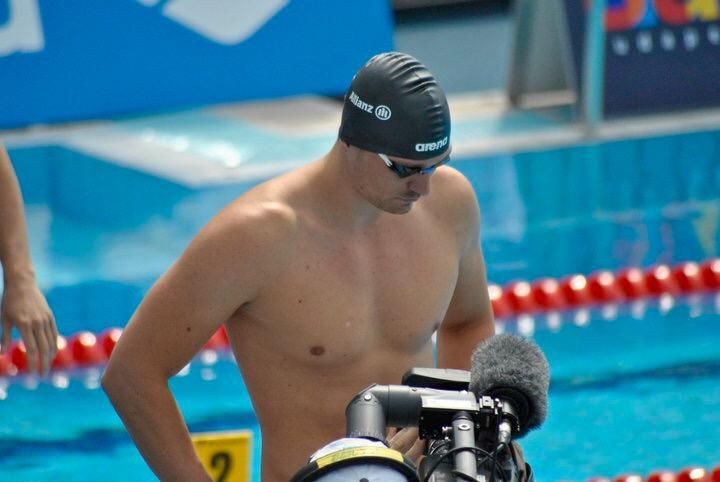Breaking Limits: The Journey of Mind, Body, and Heroic Coaching
A Holistic Coaching Approach

My addiction to water and swimming began at the age of 6, in 1991. That year, I participated in my first swimming race—the 50m breaststroke (yes, my “favorite” stroke!).
I’m from a small town in southern Hungary, near the Serbian border. Back in the “dark ages,” up until around 2002-2003, we had to swim outdoors in all kinds of weather—summer, winter, rain, or snowstorms. It didn’t matter. You got in the pool and followed the training plan. No exceptions. The pool itself was old, and until 2002-2003, the water was so dark that you could barely see your own hands beneath the surface.
It was like a boot camp, but looking back, I now realize that this experience was vital in shaping the coach I am today. It taught me the importance of discipline—understanding that a successful path comes from commitment, consistency, and resilience.
The Importance of Emotional Support in Swimming
Through my personal experiences and the coaching I received, I understand more than ever that today’s athletes—particularly swimmers—need more than just a trainer. They need a coach—someone who acts as a mentor and provides emotional support through every situation.
When I was training, unfortunately, that kind of support was often missing. The focus was solely on survival. If you made it through, you were considered mentally tough, and you might advance to a high level. But we weren’t prepared mentally in a holistic way. This kind of approach often led to mental breakdowns, emotional exhaustion, and for some (even myself), it took years to find a new purpose after leaving the sport.
When I Was Training: A 2.0 Spartan Mentality
It was a demanding, almost militaristic approach, where discipline and sheer endurance were the only measures of success. You had to be tough to make it through the endless kilometers of every session and the grueling, solely endurance-based training.
For example, a typical week could look like this: (Sub-max week, Tuesday and Thursday)
200m warm-up
4 sets of
4x100m Medley order per round @1:30
400m Individual Medley @6’
4x100m Freestyle @1:20
400m Freestyle @6’
200m cool-down
And sometimes, my coaches would even add a 3km test at the end.
Or, there was the infamous:
• 10x600m butterfly (6 times with anti-paddles, 4 times normal)
The Consequences of This Approach
The roots of this method can be traced back to when one famous Hungarian coach introduced a concept that became widely known as the Hungarian fashion model. The idea was simple: overtrain to outpace other nations, believing that if we pushed our athletes harder than anyone else, no one would be able to catch up. Back then, this was a highly effective strategy. No one else was doing such intense, endurance-heavy training. The swimmers in the 200m/400m IM and 200m Breaststroke events were virtually unbeatable.
However, as with all things, times change. As the sport evolved, so too did the understanding of training methods. Today, we know that less can be more. From my own experience, I can confidently say that with just 50-60% of the training volume that was used back then, athletes can achieve better results. It’s not about doing more; it’s about smarter, more targeted training and preparation, tailored to the athletes needs. Resilience, mental strength, and physical readiness are built more effectively with thoughtful planning rather than sheer volume. The key is in quality, not just quantity.
A Quick Anecdote: The 2006 European Championships
In 2006, I was preparing for the European Championships in the 200m butterfly. Physically, I was in peak shape. In training, I could swim 3 sets of 4x100m butterfly on 1:20, averaging 1:04-1:05 per 100m, finishing the last 100m in 57.7 seconds.
But when competition came, everything fell apart. My mental state wasn’t strong enough to carry me through. I wasn't mentally prepared to handle the situation, the pressure that comes with such races. After my disappointing performance in the 200m Butterfly, my coaches didn’t know how to respond. There were no words of encouragement, no efforts to help me refocus. They only spoke to me when I succeeded. When I failed, they were nowhere to be found.
Reflecting on the Past
Looking back, I realize that physical preparation alone isn’t enough— the athletes mental state, their mental resilience, preparation and readiness is just as important. Coaching isn’t just about building physical strength; it’s about supporting emotional well-being too. My experiences have shaped my coaching philosophy: to help an athlete succeed, you must support them in every way, at all times.
Mental Resilience Preparation: Building the Inner Strength
Mental resilience is the backbone of any athlete’s journey. It’s not simply about surviving difficult training or competitions; it’s about thriving in the face of challenges. In my own coaching, I’ve seen firsthand how vital it is to train the mind as much as the body.
True mental resilience comes from consistent, focused preparation. It starts with a mindset that embraces setbacks as opportunities for growth. Athletes must learn to face uncertainty, handle pressure, and push through the moments of doubt that inevitably arise. That’s where a coach’s role becomes critical—not only in training physical skills but in preparing an athlete’s mind to stay calm, composed, and determined when it counts.
Preparing for competition isn’t just about physical drills; it’s about teaching athletes to trust their instincts, to block out distractions, and to keep their focus even when things aren’t going as planned. The mental side of training involves helping athletes embrace the discomfort of challenge, and equipping them with the tools to stay grounded in high-pressure situations.
When I work with athletes, we focus on visualization techniques, mental rehearsals, and positive affirmations. It’s crucial to practice how to recover from a bad split, how to mentally reset after a mistake, and how to find calmness in the middle of chaos. This kind of mental resilience training helps athletes stay focused, even when their bodies are exhausted or their nerves are frayed.
The Hero Magic: Helping Athletes Break Their Limits
Throughout my coaching career, I’ve had the privilege of working with athletes who have surpassed their own limits, broken through barriers, and achieved far more than they ever thought possible. This is what I call the hero magic—though I don’t mean to sound boastful.
For me, the four most rewarding aspects of coaching are:
1. Creating the right strategy
2. Helping athletes trust the process
3. Guiding them to reach a level they never thought possible
4. Witnessing their growth as they realize the depth of their own potential, often surpassing even their expectations
The true reward of coaching is seeing an athlete succeed. When they break through their personal barriers, look at their time, and surge through the water at the finish line, I know that every minute invested was worth it. That moment when they realize their own potential , and they’ve reached a level they once thought was unattainable.is priceless
Understanding Each Athlete’s Unique Path
Every athlete is an individual with their own path to success, and unlocking their full potential requires recognizing their uniqueness. As a coach, your role is not just to teach; it’s to listen, observe, and adapt. The foundation must always be strong—trust, reassurance, and belief in their ability. This environment fosters growth.
Coaching isn’t about rigid consistency; it’s about knowing when to soften your voice and when to sharpen it. When to challenge and when to offer encouragement. Each training session, each conversation requires a different approach. In this delicate balance between firmness and compassion, direction and freedom, you unlock the true potential of your athletes.
Ultimately, coaching is not a one-size-fits-all formula. It's a dynamic, evolving conversation that's tailored to bring out the best in each athlete. The more attuned you are to their needs, the more effective your guidance will be.
The Power of Emotional Support
Let me tell you a story that highlights the importance of mental support. I often find myself helping athletes through big competitions, especially when it’s their first international meet, like a World Cup or the Junior World Swimming Championships. The best way to explain this emotional support is through a specific example.
It was one of my young, talented athletes’ first big international meet. As we got closer to the pool, I noticed some behavioral changes, so I initiated a simple conversation to understand the cause. It quickly became clear that the issue was related to pressure, so I gradually reached out and began guiding his mindset in the right direction. Eventually, we reached a point where I could give him specific instructions that would help him regain his self-confidence.
Tapped into the right emotion and mental support, he could regain his confidence and truly feel that this is his pool, his time.
It’s a simple but powerful exercise to open his mind and attitude. Here’s what I had him do:
Before warming up, stand on the block—no matter who is around or what’s happening. Stand tall with your chest out, chin up, and eyes forward. Take one minute to focus on deep inhalations and slow exhalations while maintaining this posture, then perform powerful arm swings and dive in. Enjoy every stroke surrounded by Olympic swimmers.
It’s a simple but powerful tool that I believe every coach can use when they notice a change in an athlete’s mood or mindset.
The Journey of Growth
In the end, it’s not just about the race or the performance; it’s about the journey of growth—mentally, emotionally, and physically. Every athlete has the potential to break through their limits, but to do so, they need more than just technical skills—they need the strength of mind and the resilience of spirit.
As coaches, it’s our responsibility to guide them, to support them not just in their training, but in their struggles, their doubts, and their fears. When we help athletes reclaim their confidence, when we teach them how to turn pressure into fuel, and when we remind them that they control their own destiny, that’s when true transformation happens.
Because at the end of the day, it’s not just about teaching them to swim faster—it’s about teaching them to believe in themselves, to trust the process, and to own their moment, every time they step onto that block.
Holistic Coaching: Helping shape the Individual
For an athlete, having the right coach is essential—not just as a trainer, but as a mentor and sometimes a psychologist. In tough times, a coach’s support goes beyond technique, helping athletes navigate mental and emotional challenges to stay strong and focused or even help navigate and guide through life or career matters . This guidance doesn’t just shape them as athletes—it shapes them as individuals, preparing them to handle any kind of challenge life throws their way.


